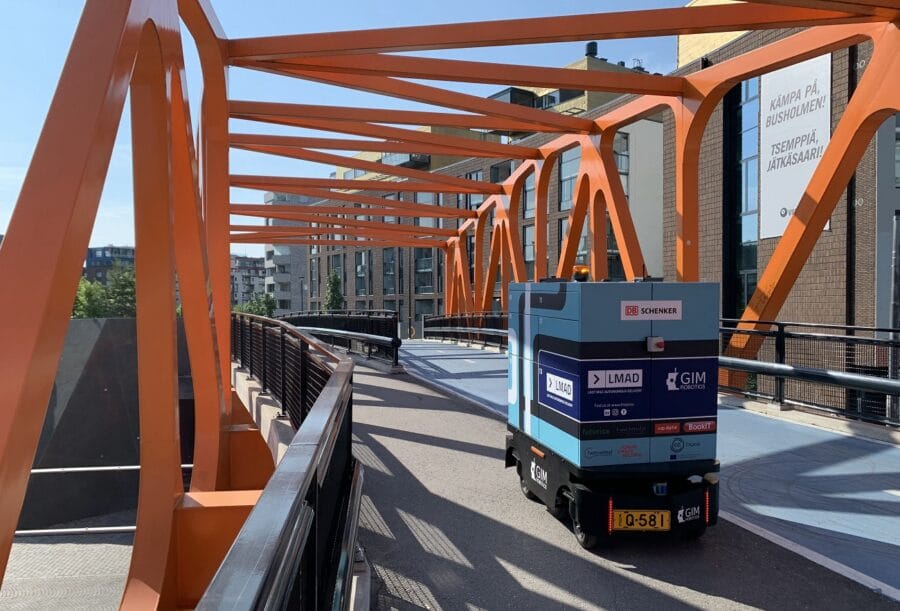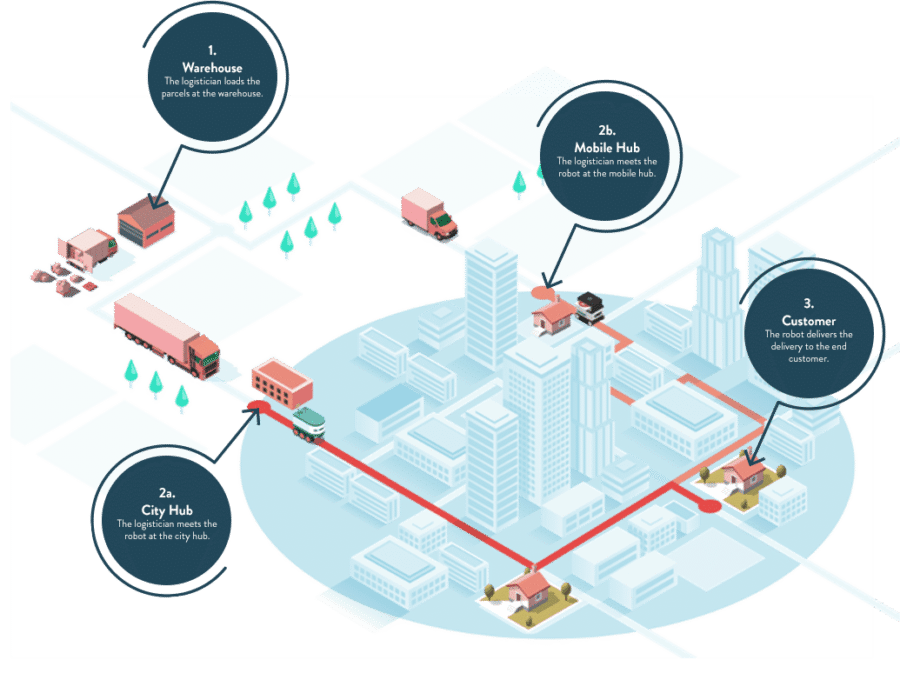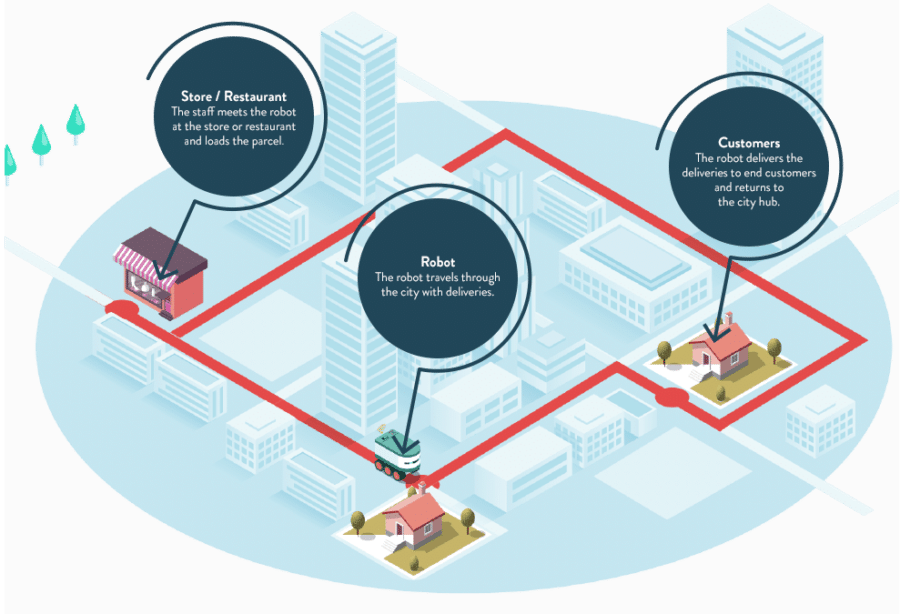Can autonomous delivery robots be used for both B2B and B2C use cases?
The last mile (or the last stretch) of the delivery route to the end customer is both challenging and expensive, at about 53% of the total delivery cost. While the first mile and the middle mile are easier to optimize—different automation solutions are en route to being tested on a scale—the challenge of the last mile is notoriously difficult to tackle, both for business-to-business (B2B) and business-to-customer (B2C) deliveries.
Autonomous delivery solutions, and autonomous robots, in particular, might provide to be a viable alternative to currently existing delivery methods.
In this article, we’ll look into both B2C and B2B autonomous delivery, and discuss the benefits and challenges of each.

LMAD’s robot in Helsinki, during our latest pilot experiment with DB Schenker (for B2C deliveries)
B2B and B2C urban delivery: can self-driving robots integrate into the urban supply chain?
Self-driving delivery robots for the last mile can integrate well into the urban supply chain and can prove to be a cost-efficient, ecological and customer-friendly solution. Before this can happen, though, the necessary legal infrastructure needs to be created: the legislative framework allowing for autonomous delivery does not yet exist in many countries.
B2B autonomous delivery in cities
Autonomous delivery solutions can be a viable option for urban B2B deliveries in a few different scenarios:
- By replacing a driver-assisted vehicle and providing a continuous, 24/7 service capacity. In this case, delivery robots can keep the operational costs much lower, and also provide very high flexibility. B2B deliveries often take place early in the morning or late in the evening; autonomous robots can help businesses expand delivery hours further.
- By replacing serial deliveries with parallel deliveries. A fleet of a few robots can make parallel deliveries, which can replace driver-operated serial deliveries. If the starting point is a city hub or a warehouse depot, self-driving robots can make deliveries at the same time for all customers and return to the starting point in a fraction of the time it takes a delivery driver to make return trips and deliver to each customer. Retailers, shopping centers, and trade areas can also be serviced by autonomous robots, once autonomous deliveries become scalable. An example of this is the partnership between Walmart and Gatik, a Californian company developing autonomous vehicles for urban logistics.
- A robot with lockers can be considered an urban hub and a mobile relay point. Robots can become moving relay points that are dispatched to different areas; customers receive information on the robot’s location, ETA, and pickup points.

Autonomous delivery solutions can optimize the route from the warehouse to the end customers
B2C autonomous delivery in cities
As part of a B2C delivery chain, self-driving robots can be convenient for both customers and businesses. They provide businesses the ability to offer a local delivery solution:
- To retailers who offer shipping from their stores. With growing customer demand, businesses often stock inventories at different locations, to guarantee rapid and efficient delivery. Self-driving delivery robots could make the link between inventory storage locations and end customers.
- To restaurants who wish to extend their delivery options. Delivery robots could offer a convenient solution for restaurants, as well, by optimizing delivery routes and providing accuracy and convenience to customers.
- To big logistics companies who wish to expand their existing delivery options. Big logistics companies can complete their service offering with autonomous robots and offer a delivery solution that’s even more convenient. Currently, we’re exploring this B2C autonomous delivery use case in our experiment with DB Schenker in Helsinki, Finland. Update: in November and December 2021, we successfully completed 100+ B2C parcel deliveries to the city’s residents.
- For customers who do not have an adequate service offer nearby. University campuses on the edge of town, for example, might only have limited delivery options. Surprisingly, even busy city centers sometimes don’t have an adequate number of delivery points or delivery options available. Again, delivery robots can take the role of a mobile delivery relay point.

Local restaurants and retailers can also benefit from autonomous solutions to reach customers more efficiently
What are the existing last-mile urban delivery solutions, and how do autonomous robots compare?
At the moment, two main options exist in cities: trucks or vans, and couriers.
Delivery trucks and vans
Trucks and vans, while having a high delivery capacity, tend to be big and polluting. In some countries, they are progressively being banned from entering city centers. Trucks and vans are often used for B2B last-mile deliveries, although B2C businesses also use them to transport goods to end customers.
For both B2B and B2C deliveries, last-mile autonomous delivery vehicles could prove to be a viable alternative to vans and trucks in cities. As autonomous robots are electric, they could replace more polluting vehicles; compared to trucks and vans, robots are also smaller and more silent, and therefore less disturbing for residents and visitors alike.
Couriers equipped with bikes, scooters, or vehicles (electric or diesel)
Couriers are now zipping through cities and generally integrate better in the urban fabric, compared to trucks or vans. Of course, they also operate at a much smaller capacity: each courier can only transport so many deliveries in a day.
Couriers typically handle B2C deliveries, but might occasionally also deliver to businesses, for example transporting documents to file or sign.
In a B2C scenario, although couriers often prove to be a convenient solution for customers, for businesses this approach to the last mile is quite expensive, and also not scalable, short of hiring and managing an increasing number of employees (or subcontractors). This means that individual deliveries to customers come with very high overhead costs. And, as a McKinsey report rightfully identifies, end customers remain very price sensitive and aren’t willing to pay higher prices for home deliveries.
Autonomous delivery solutions are more scalable and could bring down the cost of the last mile significantly, both for B2B and B2C delivery use cases. Once deployed at scale, they can also be faster than couriers. At the moment, couriers are obviously better prepared to navigate complex, unpredictable urban environments.
In most of Europe, the existing legislation doesn’t yet permit the deployment of large-scale autonomous delivery operations in public areas, and in many cases, even testing is problematic. Nevertheless, another use case exists, which we’ll look at in the next section: on-site parcel delivery at private R&D and industrial campuses.
B2B autonomous delivery at industrial campuses
Can self-driving robots be used for on-site delivery at industrial campuses?
That’s what we’re currently testing, with two of LMAD’s key experiments for this year, both of them in France, in the Parisian metropolitan area:
- Our experiment at the EDF campus Les Renardières, where we’re testing a solution for on-site delivery to the employees of EDF, that would be more convenient and less disruptive to their work, compared to collecting deliveries at the depot.
- Our experiment at the Nokia Bell Labs Paris-Saclay, where, similarly, we’re aiming to build a proof of concept for on-site deliveries to Nokia’s employees, for a solution that would be convenient, scalable, and cost-efficient.
As of now, industrial sites are an ideal testing and deployment ground for B2B autonomous deliveries: they allow for creating solutions that cannot yet exist in public areas due to legislative constraints in Europe. For companies, they can provide a simple, fast and convenient delivery solution for employees who work at campuses (which can sometimes be very large).
Conclusion
For autonomous urban logistics, both B2C and B2B autonomous deliveries are viable options that address some of the key challenges for the last mile.
While self-driving delivery robots can operate both in an urban environment and in an industrial setting, at the moment, it’s much easier to test them on private grounds, rather than in public areas. Although testing autonomous solutions in cities is also possible, as goes to show LMAD’s ongoing Helsinki experiment.

